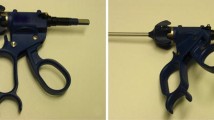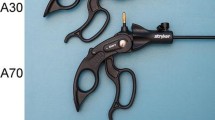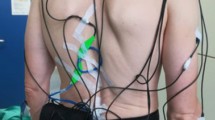Abstract
Purpose
The interface between surgeon and the laparoscopic instrument is an important factor in biomechanical stress that may increase the risk of musculoskeletal complaints in surgeons. This article investigates the effect of a laparoscopic instrument with a rotatable handle piece (rot-HP) on muscular stress and fatigue during routine laparoscopic procedures (LP) as well as usability, wrist posture and working precision.
Methods
40 LP (subtotal hysterectomies) performed by 11 surgeons were investigated. 20 LP were carried out with the rot-HP and 20 with a fixed (standard) laparoscopic handle piece instrument. Shoulder and arm muscle activity was monitored via surface electromyography (sEMG). The electrical activity (EA) and median power frequency (MPF) were used to determine muscular stress and fatigue. Usability, wrist posture, and working precision between handle piece conditions were assessed by a survey.
Results
Using the rot-HP did not reduce muscular stress. A tendency of muscular fatigue (increasing EA, decreasing MPF) occurred in the upper trapezius, middle deltoid and extensor digitorum muscles; however, no differences were found between handle pieces. Wrist posture was more comfortable using the rot-HP and working precision and usability tended to be preferred using the standard handle piece.
Conclusions
Although wrist posture seemed to be optimized by the rot-HP, no effect on muscular stress and fatigue was observed in routine LP (< 60 min duration). Optimization of wrist posture may provide positive effects in mid- or long-term procedures. However, sufficient familiarization with the new instrument is crucial since working precision and usability could be impaired.




Similar content being viewed by others
References
Balogh I, Hansson G, Ohlsson K, Strömberg U, Skerfving S (1999) Interindividual variation of physical load in a work task. Scand J Work Environ Health 25(1):57–66
Berguer R (1998) Surgical technology and the ergonomics of laparoscopic instruments. Surg Endosc 12(5):458–462
Brigstocke G, Hearnden A, Holt CA, Whatling G (2013) The functional range of movement of the human wrist. J Hand Surg (Eur Vol) 38(5):554–556
Delp SL, Grierson AE, Buchanan TS (1996) Maximumisometric moments generated by the wrist muscles in flexion-extension and radial-ulnar deviation. J Biomech 29(10):1371–1375
Esposito C, El Ghoneimi A, Yamataka A, Rothenberg S, Bailez M, Ferro M, Gamba P, Castagnetti M, Mattioli G, Delagausie P, Antoniou D, Montupet P, Marte A, Saxena A, Bertozzi M, Philippe P, Varlet F, Lardy H, Caldamone A, Settimi A, Pelizzo G, Becmeur F, Escolino M, Pascale T de, Najmaldin A, Schier F (2013) Work-related upper limb musculoskeletal disorders in paediatric laparoscopic surgery. A multicenter survey. J Pediatr Surg 48(8):1750–1756
Gandevia SC, McKenzie DK (1988) Activation of human muscles at short muscle lengths during maximal static efforts. J Physiol 407:599–613
Hansson GA, Nordander C, Asterland P, Ohlsson K, Strömberg U, Skerfving S, Rempel D (2000) Sensitivity of trapezius electromyography to differences between work tasks—influence of gap definition and normalisation methods. J Electromyogr Kinesiol 10(2):103–115
Koca D, ld z Y, Soyupek S, Gunyeli F, Erdemoglu I, Soyupek E S (2015) Physical and mental workload in single-incision laparoscopic surgery and conventional laparoscopy. Surg Innov 22(3):294–302
Krogh-Lund C, Jørgensen K (1993) Myo-electric fatigue manifestations revisited: power spectrum, conduction velocity, and amplitude of human elbow flexor muscles during isolated and repetitive endurance contractions at 30% maximal voluntary contraction. Eur J Appl Physiol Occup Physiol 66(2):161–173
Kuorinka I, Jonsson B, Kilbom A, Vinterberg H, Biering-Sørensen F, Andersson G, Jørgensen K (1987) Standardised Nordic questionnaires for the analysis of musculoskeletal symptoms. Appl Ergon 18(3):233–237
Lippert H, Koch A, Marusch F, Wolff S, Gastinger I (2002) Offene vs. laparoskopische Appendektomie (Open vs. laparoscopic appendectomy). Chirurg 73(8):791–798
Luttmann A, Jäger M, Sökeland J, Laurig W (1996) Electromyographical study on surgeons in urology. II. Determination of muscular fatigue. Ergonomics 39(2):298–313
Marion MS, Wexler AS, Hull ML, Binder-Macleod SA (2009) Predicting the effect of muscle length on fatigue during electrical stimulation. Muscle Nerve 40(4):573–581
Mathiassen SE, Winkel J, Hägg GM (1995) Normalization of surface EMG amplitude from the upper trapezius muscle in ergonomic studies—a review. J Electromyogr Kinesiol 5(4):197–226
Park A, Lee G, Seagull FJ, Meenaghan N, Dexter D (2010) Patients benefit while surgeons suffer: an impending epidemic. J Am Coll Surg 210(3):306–313
Quick NE, Gillette JC, Shapiro R, Adrales GL, Gerlach D, Park AE (2003) The effect of using laparoscopic instruments on muscle activation patterns during minimally invasive surgical training procedures. Surg Endosc 17(3):462–465
Rassier DE, MacIntosh BR, Herzog W (1999) Length dependence of active force production in skeletal muscle. J Appl Physiol (Bethesda Md 1985) 86(5):1445–1457
Rothmund R, Kraemer B, Neis F, Brucker S, Wallwiener M, Reda A, Hausch A, Scharpf M, Szyrach MN (2012) Efficacy and safety of the novel electrosurgical vessel sealing and cutting instrument BiCision®. Surg Endosc 26(11):3334–3343
Rothmund R, Szyrach M, Reda A, Enderle MD, Neugebauer A, Taran F, Brucker S, Hausch A, Wallwiener C, Kraemer B (2013) A prospective, randomized clinical comparison between UltraCision and the novel sealing and cutting device BiCision in patients with laparoscopic supracervical hysterectomy. Surg Endosc 27(10):3852–3859
Seibt R (2013) Quantitative definition muskulärer Ermüdung. Zbl Arbeitsmed 63(5):266–269
Steinhilber B, Seibt R, Reiff F, Rieger MA, Kraemer B, Rothmund R (2016) Effect of a laparoscopic instrument with rotatable handle piece on biomechanical stress during laparoscopic procedures. Surg Endosc 30(1):78–88
Steinhilber B, Reiff F, Seibt R, Rieger MA, Martus P, Kraemer B, Rothmund R (2017) Ergonomic benefits from a laparoscopic instrument with rotatable handle piece depend on the area of the operating field and working height. Hum Factors 59:1048–1065
Uhrich ML, Underwood RA, Standeven JW, Soper NJ, Engsberg JR (2002) Assessment of fatigue, monitor placement, and surgical experience during simulated laparoscopic surgery. Surg Endosc 16(4):635–639
van Veelen MA, Jakimowicz JJ, Kazemier G (2004) Improved physical ergonomics of laparoscopic surgery. Minim Invasive Ther Allied Technol 13(3):161–166
Acknowledgements
We thank Florian Reiff, Gabi Weiss and Florian Ulbrich for their assistance during data acquisition as well as Tabea Pomes for her contribution to sEMG data analysis.
Funding
This research was partly funded by ERBE Elektromedizin GmbH, Germany. The work of the Institute of Occupational and Social Medicine and Health Services Research. Tuebingen is supported by an unrestricted grant of the employers' association of the metal and electric industry Baden-Wuerttemberg (Suedwestmetall).
Author information
Authors and Affiliations
Contributions
BS, RR and BK initiated the research project. BK, BS, RS, RR, SB, and MR conceived and designed the study protocol. BK, RR, SB, AS performed data acquisition. BS and RS performed the statistical analysis. BK, AS, and BS drafted the manuscript. All authors were included in data interpretation process. All authors critically reviewed and revised the manuscript. All authors approved the final manuscript. The results of this study are used in the doctoral thesis of AS.
Corresponding author
Ethics declarations
Conflict of interest
Prof Dr. Bernhard Kraemer, Robert Seibt, Dr. Anne-Kathrin Stoffels, Prof. Dr. Ralf Rothmund, Prof. Dr. Sara Y. Brucker, Prof. Dr. Monika A. Rieger and Dr. Benjamin Steinhilber have no conflicts of interest or financial ties to disclose.
Informed consent
All subjects gave their informed written consent and the study was approved by the ethics committee of the medical faculty of the University of Tuebingen (409/2013BO1).
Rights and permissions
About this article
Cite this article
Kraemer, B., Seibt, R., Stoffels, AK. et al. An ergonomic field study to evaluate the effects of a rotatable handle piece on muscular stress and fatigue as well as subjective ratings of usability, wrist posture and precision during laparoscopic surgery: an explorative pilot study. Int Arch Occup Environ Health 91, 1021–1029 (2018). https://doi.org/10.1007/s00420-018-1344-1
Received:
Accepted:
Published:
Issue Date:
DOI: https://doi.org/10.1007/s00420-018-1344-1




